
Six Cent Lincoln Bank Notes
The Secret Mark
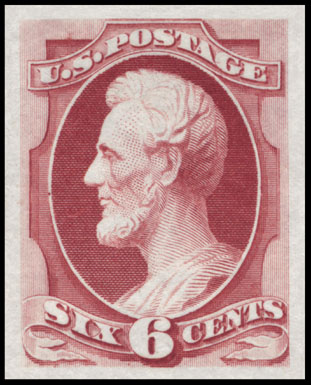
Scott 148P3 - National Printing
Original Design - Proof on India
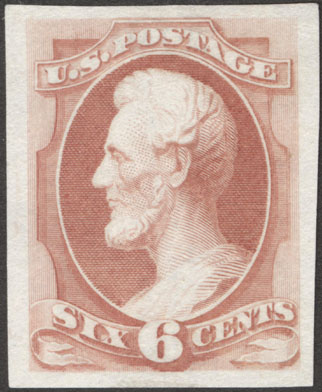
Scott 159P3 - Continental Printing*
With Secret Mark - Proof on India
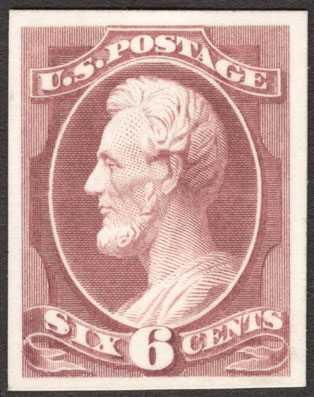
Scott 208P4 - American Printing
Reengraved Design - Proof on Card
Closeup of the Secret Mark
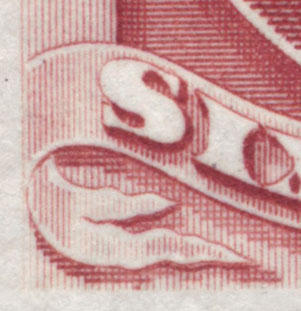
Scott 137 and 148 - No Secret Mark
National Bank Note Co. - There is no extra shading in the lower ribbon below the "S" in "SIX". Note that the color is a much richer shade of carmine than the Continental printings.
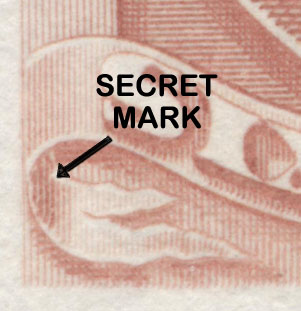
Scott 159 and 186 - Secret Mark
*Continental & American Co. - Four lines of shading have been reinforced in the lower ribbon below the "S" in "SIX". Note that the color is a much duller, pinkish shade than the National printings.
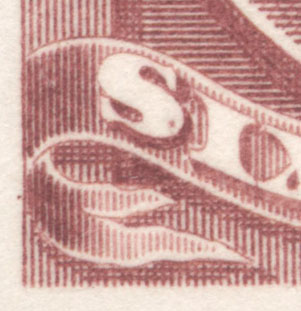
Scott 208- Added Shading
Re-engraved American - Shading has been reinforced in the ribbon to the left of the "S" in "SIX" and the ribbon below. The color may range from a dull rose to a deep brownish red.
Six Cent Lincoln Bank Note - Original Vs Reengraved Design
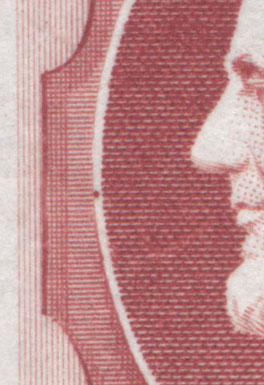
Closeup of the Original Design
4 Fine Lines Left of Inner Frame
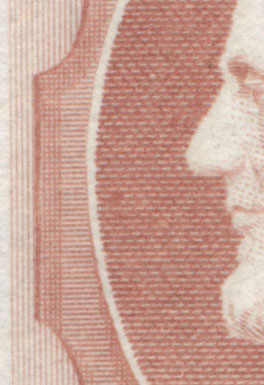
Original Design with Secret Mark
4 Fine Lines Left of Inner Frame
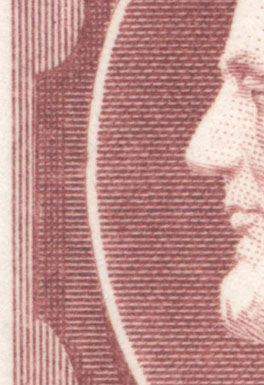
Closeup of the Reengraved Design
3 Heavier Lines Left of Inner Frame
Follow these steps in the identification of your six cent Bank Note:
Determine the type of paper the stamp was printed on. If it was printed on "hard white" paper it is either a National or a Continental printing. The National printings can often be separated by color alone, the color is quite a bit more vivid in general than the Continental and American printings. By way of example, the stamp at the top of this page is a proof of the National Bank Note Printing, Scott 148, and illustrates the intense carmine shade well.
The stamp should also be checked for the "secret" mark. If the stamp was printed on hard white paper and does not have the secret mark, it was printed by the National Bank Note Company and is either Scott 137, with grill, or Scott 148, without grill. Care must be taken when authenticating the grill. Many fake grills have been added over the years in an attempt to increase the value of the stamp. If you suspect your six cent National stamp has a grill, you must have it certified.
If the stamp was printed on hard white paper and it does have the secret mark, it was printed by the Continental Bank Note Company and is Scott 159. Some of these are known with grill, Scott 159b, and again, if you think your Scott 159 has a grill, expertization is a necessity.
If the stamp was printed on "soft porous" paper, it is an American Bank Note printing, either Scott 186 or Scott 208. Compare the number of lines in the panel to the left of the inner frame as shown in the illustrations above to determine whether the stamp is the original or reengraved design. The lines in the panel must be distinct for the stamp to be a Scott 208. Also note the muddy color of the reengraved stamp.
Watch for re-perforation (to fake a more well-centered stamp), for re-gumming (a major problem with the Bank Notes), and even for bleaching of the cancellation (to remove the cancel). Unused copies carry a substantial premium over the used stamp.
The Special Printings, Scott 170 and 195, are mentioned here merely for completeness. Only 185 copies, total, of Scott 170 and Scott 195 were sold, and they were never issued for postal use, rather for collectors only. We occasionally see uncertified copies of these stamps offered for sale at ridiculously low prices. You can rest assured that the stamp being offered is not genuine. These stamps are so rare, only 65 copies are known, they seldom come up for sale except in the sale of a major U.S. Collection.





